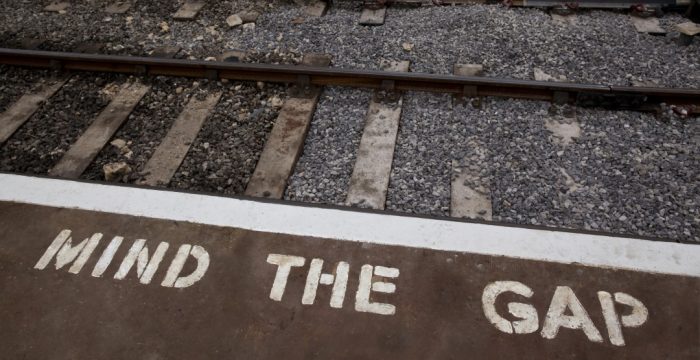The Reality-Potential Gap and
How to “Mind It”

If you’ve ever been to London and used the underground railway, you may have read the bold eye-catching phrase “Mind the Gap” at your feet, or jumped in alarm when the audible warning alerted you and other railway passengers to take caution while crossing the gap between the train door and the station platform.
The phrase “Mind the Gap” was coined in 1968 after it became impractical for station attendants to warn passengers.
Accidents at the London Underground had become commonplace, and there was an urgent need to help passengers know when they were about to step into a danger zone.
There may have been a more conventionally polite British way for the London underground to suggest the next safe step, but with digital recording being what it was in ‘68, the recording equipment and data storage were expensive. So a brief instructive phrase was chosen (which also happened to be easier to paint on the platform step).
Were it so convenient for you to have a clear warning sign each time you stepped out into the unknown….

Fear of
the Unknown, or FOTU (Carleton, 2016), is absolutely the WORST (or fundamental,
at least) fears of humankind.
Worse even than fear of pain or fear of death. FOTU is responsible
for most of our underlying social or health anxiety, panic, depression, anger,
PTSD, personality disorders, and what has become our general cultural
neuroticism.
Fear of the Unknown is the linchpin to why you
don’t move forward in life.
You’re afraid it’s going to be worse than where you are now. Hands
down, not worth one damn step forward.
No wonder your fear of the dark spaces under a childhood bed,
around the curve of a long obscured staircase, or upon meeting your
sweetheart’s parents. So much can go bad in a very short time.
Why
Mind the Gap?
Knowing the Gap (between our current Reality and the Potential)
helps you calibrate your expectations and prepare to at least assume that…
…you don’t know what you’re getting into, and that it could be
different than you imagine.
But Different doesn’t have to equate to Bad.
Part of the reason to Mind the Gap is to both:
·
Know where the bounds of safety are, and
·
To have enough capacity to get across the gap.
I love the best-selling book Transitions by
William Bridges (1980). He suggested that change is something that happens to
people, even if they don’t agree with it. Transition, on the other hand, is
internal: it’s what happens in people’s minds as they go through change. Change
can happen very quickly, while transition usually occurs more slowly.
Or, in other words, change is easy. Transition is what’s hard.
So stepping from one side of a train platform that seems safe and
solid, onto an imminently-moving train over a big gap, feels perilous.
You hesitate, take a deep breath, and put your foot out into the
unknown.
And of course the same applies to all parts of your life. You’d
get stuck in your house robe and socks, sucking down another cup of coffee (or
matcha), if you only imagined that getting out the door to work would be
perilous (which it is, often.)
Instead, you use your visualization skills and imagine a different
future for the day.
You know how this goes.
Each and every day of your life you:
·
Imagine what’s possible for yourself, sometimes better than the
day you had yesterday (an inconceivable vision) and
·
Know that it will be different than any expectations you’re going
to create anyway (imagining possibility).
So whatever occurs as you make your way down the tracks, you have
to imagine you can handle it, or you wouldn’t go at all.
You’re prepared for the unexpected. To be surprised.
Are you with me?
So if that’s true, then what if you could imagine an even
different scenario?
What if you Minded the Gap from your Current Reality to a
Potential that’s so different than what you expect, or can conceive of today,
that it blows your minds and socks off (and you get out of your metaphorical
house robe)?
What if, in fact, you’re really re-creating the same scenario, day
after day, in your life by having very low or limited expectations of what’s
possible?
What would life look like if, instead of imagining the worst, you
imagined the (previously) inconceivable instead?
What
if you could look out ahead and see the gap, and have Clarity and Confidence
that you could jump over it?

That on the other side
would be YOUR success, meaning, focus, ease, impact, abundance….
If you knew….
…that Thoughts Become
Things and that a Possibility Mindset™ could simultaneously Mind the Gap and
help you get
across it to your
purpose-driven Big Vision…
Would you be willing to
take a step?
The science and practice
of living into your FOTU and getting across the gap are all clear, reasonable
and can take you there.
You’re gonna have to
have a leap of faith and trust me on this.
After 35+ years of
taking people there with a practical and science-based model, it’s possible.
All you have to do is
answer a few questions.
Here’s Your Assignment:
· What’s your dream?
What’s across the chasm in your Reality to Potential Gap?
· What’s stopping you?
What are the elements of your FOTU that keep you in your metaphorical house
robe?
· What kind of assurance
do you need to take the first bold step?
No need to jump before
you’re ready, but the platforms haven’t turned out to be so solid, either.
Let’s keep
talking.
References
William Bridges (1980).
Transitions: Making Sense of Life’s Changes.
Carleton, R. Nicholas.
2016. Fear of the unknown: One fear to rule them all? Journal of Anxiety Disorders Volume 41, June
2016, Pages 5-21 https://doi.org/10.1016/j.janxdis.2016.03.011

